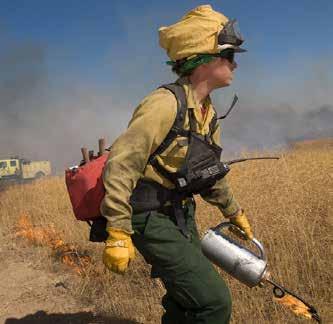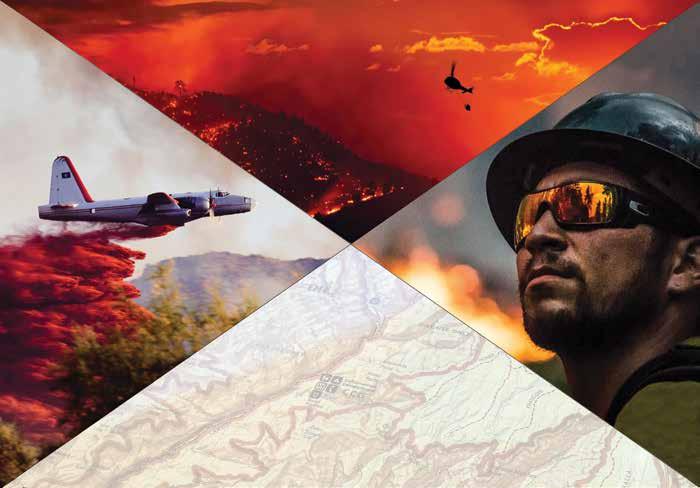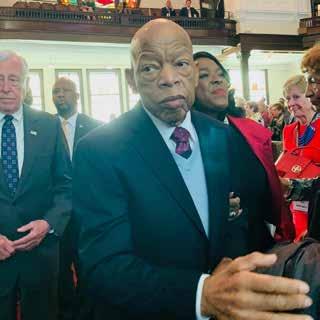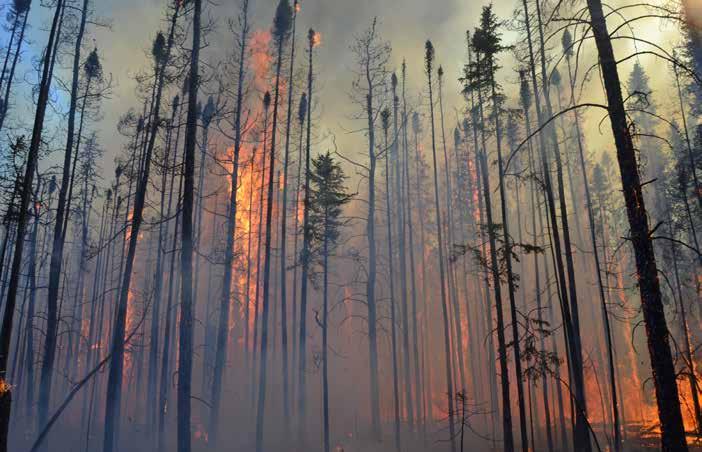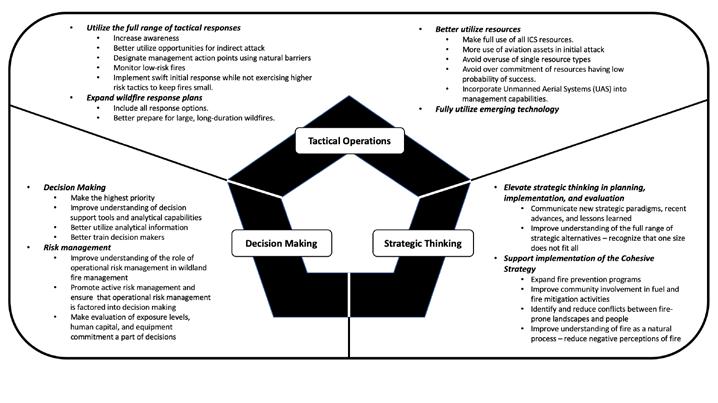
18 minute read
IAWF NEWS Scholarships, board nominations, conference news
2020 IAWF SCHOLARSHIPS
Each year the International Association of Wildland Fire (IAWF) awards two graduate-level scholarships typically valued at $3,000 USD to Master of Science (M.Sc.) or Ph.D. students studying wildland fire or wildland fire-related topics. Student-submitted essays are evaluated by an international panel of fire science experts and one award recipient is chosen for the Masters level and one for the Doctoral level. The IAWF has been presenting this award annually to members of the fire science community since 2007.
Advertisement
Congratulations to the 2020 Scholarship Recipients.
Mary Armstrong, MSc Student, University of Florida
As a master’s student at the University of Florida in the School of Forest Resources and Conservation, Mary is writing her thesis on the effects of season of prescribed fire on reproductive characteristics of several species in the Asteraceae and Poaceae families. After receiving her bachelor’s degree in Environmental Studies from Eckerd College, she began her career in prescribed fire with The Nature Conservancy in southeast Georgia. Since then, she has worked on prescribed fire crews with The Department of Natural Resources in Georgia, Lake Travis Fire Rescue in Texas, and Wildland Restoration International in Florida. She has also worked wildfire suppression on an engine and helicopter crew in Helena, Montana. After four years of field work, she decided to continue her education at the University of Florida to expand her knowledge of ecosystems and prescribed fire, and to write a thesis that could assist land managers in their decision making. In her fire career, she learned that land managers across all four states have many similar research questions. Her goal is to conduct research to help answer these questions, beginning with timing of fire and its effects on the reproduction of groundcover plants.
Robert Scott, PhD Student, Sociology, University of Colorado Boulder
Robert received a BS in Sociology from Westminster College (Salt Lake City, UT) and an MA in Sociology from the University of Victoria (Victoria, BC). He is a PhD student in Sociology at the University of Colorado and has worked in various fire management positions (Type 1 Crew Member, Type 1 Crew Leader, Provincial Training Officer) for the Government of Saskatchewan.
For his doctoral research, Robert uses historical and interview methods to investigate how single- and multiplefatality incidents involving firefighters affect the construction of self among other firefighters. The research includes a comparative analysis of Canadian and American firefighter fatalities that occurred in a 30-year period. Robert is especially interested in how firefighter fatalities influence who firefighters become in terms of their subsequent experiences and perceptions of risk. He anticipates his research will have significant value for the wildland fire community as well as occupations involving risk.
SAVE THE DATE FOR SAFETY SUMMIT AND HUMAN DIMENSIONS
Save the Date for our upcoming 16th International Wildland Fire Safety Summit and 6th Human Dimensions of Wildland Fire Virtual Conference. Since 1997, the International Wildland Fire Safety May 23 - 27, 2021 FIRE SAFETY SUMMIT 16th INTERNATIONAL WILDLAND 6th HUMAN DIMENSIONS OF WILDLAND FIRE CONFERENCE Save Date the VIRTUAL CONFERENCE Summit has been the firesafety-humandimensions2021.com
gathering place for members of the global wildland fire community to focus on how we keep our workforce and communities safe. This event is a time for us to discuss significant events and trends in safety, to promote best practices in safety training and operations, to share safety related research findings, and to explore new approaches to both firefighter and community safety. Likewise, since 2007, the Human Dimensions of Wildland Fire Conference has aimed to advance the knowledge and practice related to the social, political, economic, psychological, and other human aspects of managing fire prone landscapes. This joint conference offers a forum where past experience and lessons learned are documented, current work showcased, and emerging ideas/technology presented to provide a strong foundation for reflection and action to set the future course of practice, management and research in response to local, regional and global challenges. The 2021 conference will place particular, but not exclusive, emphasis on the COVID-19 and its effects on wildland fire management and our communities around the world. This Virtual Conference in May 2021 will allow us to reach a truly international audience, with global topics and speakers from around the world, on most continents and most time zones.
IN CASE YOU MISSED IT! 3RD INTERNATIONAL SMOKE VIRTUAL SYMPOSIUM (ISS3)

The 3rd International Smoke Virtual Symposium (ISS3) was held earlier this year and was very well received by everyone who joined! All the presentations were recorded and are available for viewing on the Virtual Conference Platform. We have reduced the registration fee to $125 ($55 for students). All presentations will be available through April 2021. https://www.iawfonline.org/ event/3rd-international-smoke-symposium/
NOMINATIONS FOR THE IAWF 2021 AWARDS BEGIN SEPTEMBER 23
We encourage you to gather your information to nominate some very deserving folks for these prestigious awards! The recipient does not need to be an IAWF member to receive an award. If you have nominated someone in the past and they were not selected as the recipient, please do not hesitate to re-nominate them.

The purpose of the IAWF EMBER AWARD is to acknowledge sustained achievement in wildland fire science. The name ‘Ember’ was chosen to reflect the fact that research and science often move slowly, and their benefits or impacts may not be apparent for years or more.
The “Management Award” was established to honor achievements and excellence in the management of wildland fire programs. This award recognizes an individual who have made lasting contributions in program management and inspired others through their creativity, innovation, leadership, application, guidance, and communication in response to challenging and controversial wildland fire management issues.
Early Career Award in Fire Science
This award is to recognize a promising early-career professional who has demonstrated outstanding ability in any field of wildland fire science. Early career is nominally taken to include professionals who are under 40 years of age when nominated.
Early Career Award in Fire Operations
This Award is to recognize a promising early-career professional who has demonstrated outstanding ability in any field of wildland fire operations. Early career is nominally taken to include professionals who are under 40 years of age when nominated.
REVIEW: “PRESCRIBED BURNING
IN AUSTRALASIA – THE SCIENCE, PRACTICE AND POLITICS OF BURNING THE BUSH”
Editors:
Adam Leavesley, Mike Wouters and Richard Thornton burning can and should now be resumed by present day
Fire has been a force in the Australian landscape for of Aboriginal people still active in burning practices. Times millennia and prescribed burning has been practiced for at have changed, the landscape is changed, but, argues Dean least 50,000 years by the First Peoples. And yet, here we are. Freeman, a Wiradjuri man and a divisional commander in Still debating its merits. Still trying to get the square peg of the ACT Parks and Conservation Service, fire management science into the round holes of community values, political is often too inflexible. ideology and entrenched operational practices. Most of the traditional custodians of southern Australia
The debates roared around prescribed burning in the recognize that times have changed and will be glad for the Australian summer of 2019-20. Much of this book was opportunity to work with conservation agencies and other written before those fires but the range of views provide a land managers to manage and burn country within the timely frame to review this historic year for fire and plan for frameworks that exist today. At the same time, it is hoped what may lie ahead. that the Australian community recognises that the use of fire
In the introductory chapter, editor Dr. Adam Leavesley was a fundamental skill of Aboriginal people and that the declares that this book features a broad range of views on the reintroduction of Aboriginal burning to southern Australia science and practice of prescribed burning, but he adds, it is has the potential to deliver many benefits to society. “not a social science study.” The core of the book has chapters grouped under
But it is through the lens of social science that makes this Evidence-Led Management, with contributions from many book most interesting. Prescribed burning is, to take the title of the current leading scientists and practitioners in this field of his opening, Different Things to Different People. The in Australia and New Zealand. basic principle of putting fire into the landscape to reduce The topics range from the broad to the local. Prescribed the risk of larger, uncontrolled wildfire is barely questioned across the 300 pages. The differences arise in how you burn, where you burn, why you burn. And those differences are told by 51 fire and land managers, and researchers, from across Australia and New Zealand.
There is much focus on the use of fire by Indigenous Australians and how much of it is misunderstood by the general population. As Leavesley calls it, it is part of the “whitefella dreaming conversation”; essentially a mythological view held by nonAboriginal people on how the country was burnt pre-European colonization and how that type of non-Aboriginal land managers. This is not the point of view Prescribed burning in South Australia, Ngarkat Conservation Park.
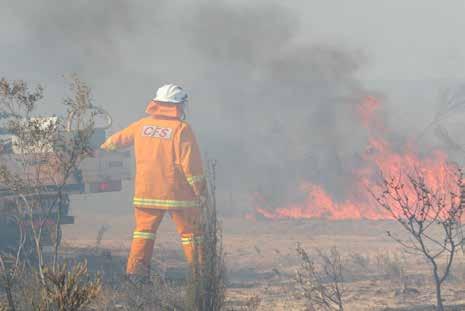
Prescribed burning in South Australia, Ngarkat Conservation Park. burning on central Australian desert land, on the fringe urban settings of capital cities, and in the tropical savannahs. Burning for ecological outcomes. Burning amongst the fire sensitive plants in Tasmania. Burning under the growing influence of climate change. The impacts on forest carbon and water. The impacts on landscape erosion and on native fauna and ants.
This in-depth analysis is disrupted throughout the book by small Photo Focus features that rely on good photography and minimal text to make a point – on aerial ignition, ignition patterns, smoke management, forestry regeneration burns, burning for Gouldian Finches, the pioneering work of Alan McArthur, and more.
A book that is imbedded with so much evidence-based science dedicates its final 18 chapters - a third of the book, no less - to Expert Opinions. Can there really be that many opinions on how to do prescribed burning? Dr. Kevin Tolhurst, researcher and teacher, calls for more fire in the landscape but laments the lack of skills and resources to
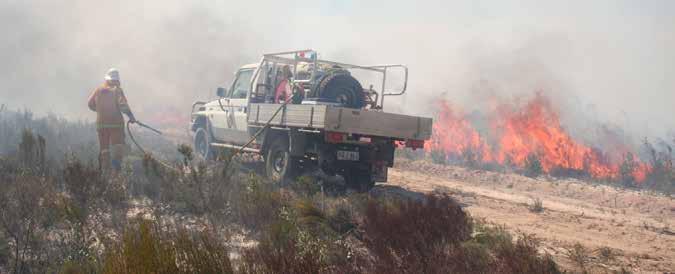
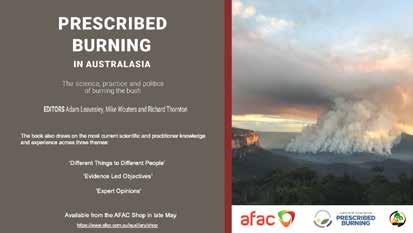
achieve this: “The complexity and importance of good fire management is not recognised in most of Australia. Instead, we have opted to use a response-driven management paradigm because it is easier for the public, politicians and media to understand and accept.”
As bushfire took hold on much of the southeast Australian states early this year, the public and political voices, both informed and uninformed, suddenly had long-held opinions on prescribed burning and its impacts on uncontrolled wildfire. On any given day it was in equal parts raised as the solution and pilloried as the cause.
Meanwhile, this year as in any other year, writes co-editor Dr. Richard Thornton, “…many local land management authorities are just getting on with the job – and dealing with the equal mix of complaints and praise on a daily basis.”
Several IAWF connections are present with Dr. Adam Leavesley a Wildfire Contributing Editor, former IAWF Board member Dr. Richard Thornton as a co-editor, and current Board members, Murray Carter and Naomi Stephens, submitting chapters. The immediate past president of the IAWF Alen Slijepcevic also writes. This book is the final product of the National Burning Project, which brought together knowledge and practices from across Australia to build a more holistic and consistent approach to prescribed burning. Buy from the AFAC Shop: https://www. afac.com.au/auxiliary/shop Review by David Bruce, Communications Director for the Bushfire and Natural Hazards Cooperative Research Centre and IAWF board member.
CRAFTING A FIRE SYSTEM FOR THE FUTURE ______________________________________________________ A perspective on matching modernization with changing complexity in our Wildland Fire Management System ______________________________________________________
BY TOM ZIMMERMAN AND JOE STUTLER
Tom Zimmerman and Joe Stutler are retired employees of the US Forest Service who were fortunate enough to have long careers in wildland fire management. Collectively, they have worked at all levels of the organization and served on Incident Management and Area Command Teams with a combined experience in excess of 100 years. What is offered here is by no means a full prescriptive analysis of the state of wildland fire management but represents the authors’ observations, thoughts, and perspectives about the needs of our wildland fire management system in these changing times. Tom Zimmerman is Strategic Coordination Advisor and Past President of the International Association of Wildland Fire and Joe Stutler is Senior Advisor for Deschutes County, Bend, OR.
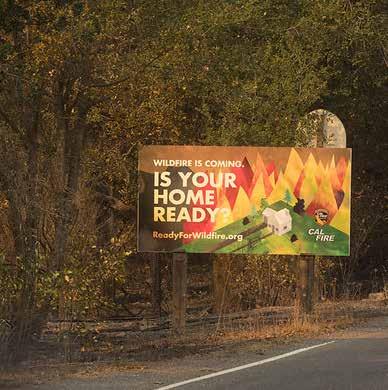
A CalFire PSA sign promotes Firewire readiness on Hwy 128 near Healdsburg, Calif., on the Kincade Fire in 2019. PHOTO: Kari Greer.
1. Today’s situation, tomorrow’s destination – a more challenging complexity
Today’s society exists in a continuum of weather, climate, vegetation, social and economic values, and political concerns that places enormous influences on wildland fire. Understanding the interrelationships involved in this is a critical step in comprehending the complexity surrounding wildland fire management.
Significant changes are taking place today, most of which are dramatic and rapid. Modified wildland fuel complexes, expanded wildland-urban interface (WUI) areas, increased human-caused fire numbers, changing climatic conditions, altered fire regimes, and shifting social/cultural perspectives provide little doubt that we are in a period of worsening complexity. These changes are triggering extensive and uncompromising, shifts in the behavior, extent, and effects of wildland fires and it can be easily seen that the degree of difficulty in accomplishing wildland fire management objectives is becoming immeasurably more complicated.
The subsequent wildland fire impacts to social, management, economic, and political values present far-reaching management challenges. Demands on and expectations of decision-makers and responders are rapidly mounting and firefighter risks and suppression costs are reaching unprecedented levels. These trends are not necessarily new, but the erratic nature and speed of change now taking place are becoming increasingly alarming.
To more effectively respond to complexity, the wildland fire management program must be viewed as a wildland fire management system and evaluated in terms of how well it can meet future challenges. The state of the program may be considered well positioned to move into the future as fire knowledge; science, technology, and operational capability; policy maturation level; and the understanding of management strategies and tactics have never been more complete. But, while many actions have been planned and implemented with countless successes realized, the future is necessitating
intensified and diversified actions to keep pace with changing conditions and shifting complexity. The wildland fire management system must be modernized at a rate greater than that of increasing complexity. Decisions and actions must be adapted, the body of knowledge must be enlarged, experience must be expanded, and capabilities boosted. There is much that can and should be done to ensure sustained stability and success in the wildland fire program.
What the future challenges will be and how they will be responded to are powerful and thought-provoking unknowns. While the answers are uncertain at this time, this paper offers questions about capability, discusses wildland fire management as a fire management system, and provides thoughts on opportunities for advancing the wildland fire management system to keep pace with changing complexity and better meet future challenges.
2. A Wildland Fire Management System – anchored in Cohesive Strategy
A number of elements influence wildland fire management. Those that shape program direction, program structure and function, and planning and implementation are most influential. These include the framework of policies, strategic plans, land and resource management plans, and other guiding documents. They provide program guidance, expanded flexibility, and the structure to keep pace with a dynamic situation, while embodying the state of the knowledge, the state of the art, and the latest science and technology.
Flexibility in program direction is extremely important since a viable one-size-fits-all management option does not exist and even if it did, is not desirable.
Each year, escalating complexity and experience bring “new firsts” that increase appreciation of change and awareness that wildland fire management must be viewed as a complex system. While other articles discuss this approach, (Thompson et.al. 2018: Christiansen 2019), we frame our discussion of this system in terms of three principal components: strategic goals as system outcomes; functional drivers of the system; and factors limiting the system (Figure 1).
The strategic goals from the National Cohesive Wildland Fire Management Strategy (USDI-USDA 2014) can be viewed as outcomes from the wildland fire management system and comprise the top portion of Figure 1, shown in a patterned fill. These goals provide a full range of flexible outcomes, set the stage for a wide range of actions, promote multi-focus thinking, and provide for a range of comprehensive objectives.
We identify three functional elements as primary driving factors of the system (Figure 1). They consist of strategic thinking; decision-making; and tactical actions and full use of available options, which are shown in the center of the figure in white. It has been stated that outcomes of the fire management system are driven by a suite of environmental, social, political, financial, and cultural factors (Christiansen 2019). But, we view these in terms of realities that are highly important due to their influence in restricting program development and advancement. These consist of management realities, social realities, and ecological realities, shown in the lower portion of Figure 1 in solid colors.
Figure 1. The Wildland Fire Management System showing interrelationships of program elements of strategic thinking, decision-making, and tactical actions with National Cohesive Strategy goals and perceived limitations to program advancement.
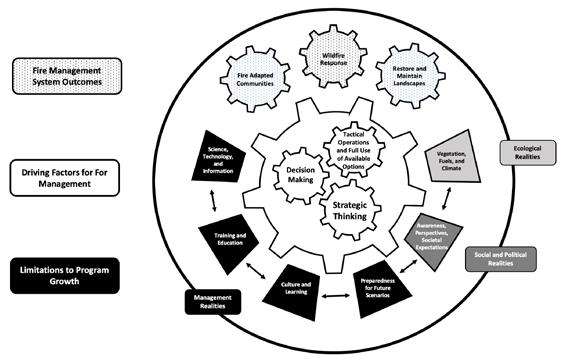
From this view of the fire management system, it is clear that the desired range of outcomes is dependent on the three primary driving factors. These driving factors are highly intertwined and must function in coordination with each other to make the system work efficiently. But they can be limited by many aspects of management, social and political, wildfiremagazine.org | wildfire 17
and ecological realities. These realities, individually or in concert, can very quickly become barriers to program function by limiting any of the three driving factors (Figure 1).
3. Is modernization needed to meet challenges and match complexity?
A solid framework and the right tools and processes currently exist, but continued forward movement must build on emerging tools and processes to modernize capabilities. Progress must be monitored and assessed to ensure focus is not lost and energy is not wasted. Every opportunity must be evaluated and acted on. Failing this, the program will lapse into passive management fueled by a flawed thought process. This faulty approach will not succeed in the future; it will allow challenges to overwhelm managers and force reactionary decisions and responses without sufficient forward-thinking.
Awareness of this situation is increasing. Christiansen (2019) highlights opportunities to improve the wildland fire management system, states that a new approach is needed and reinforces how the Cohesive Strategy is providing more opportunities for improvement. Bosworth and Williams (2018) advocate for a more imaginative approach to wildland fire management and Thompson et al. (2018) support reevaluation of the fire management system.
To be progressive in management and implementation, there are some certainties that cannot be ignored if specific answers about future direction are to be found. Table 1 provides a list of these certainties associated with wildland fire management today and pertinent questions for the future.
To answer these questions, attention must be given to the three driving elements of the wildland fire management system to provide clarification that modernization must be reflected in these areas and priorities must be identified. Strategic Thinking: Strategic thinking enables focus and drives active, progressive, and long-term assessment and action. It powers both decision-making and implementation of tactical actions. Without strategic thinking, decision traps such as over-reliance on past experience, over-emphasis on a specific tool or process, seeking a single and simple answer or a “one size fits all” management action, or lapsing into singlefocus thinking and action will result.
Table 1 . Uncommon certainties of today and questions surrounding tomorrow’s wildland fire management.
CERTAINTY QUESTIONS FOR THE FUTURE
Over-indoctrination with unwise information places excessive pressure to see truth. • Is the changing complexity of wildland fire management fully understood? • Is changing complexity being ignored due to historic fire management culture?
Change is hard and pervaded by reluctance to accept, and put into practice. Repeated practices do not cease to be ill-advised simply because they have long been accepted as the norm. • Does the capability, and will, for developing and implementing the necessary operational change exist? • Is a passive management stance letting changing conditions drive decisions and actions or is active decision-making being used to influence change and help field better responses? • Are new perspectives being heard and recognized?
Investing in the future is not foolish but is perhaps the most valuable contribution.
Great leadership does not mean ignoring reality. • Are employee skills and agency capabilities being advanced? • Are future skill, education, and training needs being anticipated and prepared for?
• Is the wildland fire management system being modernized at a rate commensu rate with increasing complexity? • Are strategic thinking, precise tactical actions using all available options, optimal use of prescribed fire and fuel treatments, science and technology, up-to-date and imaginative training, and upgraded processes to improve deci sion-making and implementation being incorporated into management at the proper rate? • Are new capabilities, knowledge, and opportunities being endorsed? • Are decisions reflecting commitment to safety by actively incorporating risk management? • Is active learning occurring and based on the best information?

